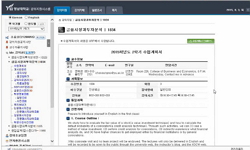High-strength concrete (HSC) is becoming increasingly attractive for various construction projects since it offers a multitude of benefits over normal-strength concrete (NSC). Unfortunately, current design provisions for shear capacity of RC slender b...
http://chineseinput.net/에서 pinyin(병음)방식으로 중국어를 변환할 수 있습니다.
변환된 중국어를 복사하여 사용하시면 됩니다.
- 中文 을 입력하시려면 zhongwen을 입력하시고 space를누르시면됩니다.
- 北京 을 입력하시려면 beijing을 입력하시고 space를 누르시면 됩니다.
https://www.riss.kr/link?id=A105889793
- 저자
- 발행기관
- 학술지명
- 권호사항
-
발행연도
2007
-
작성언어
English
-
주제어
genetic algorithms ; analysis ; high-strength ; concrete ; beams ; prediction ; shear
-
등재정보
SCIE,SCOPUS
-
자료형태
학술저널
-
수록면
51-68(18쪽)
- 제공처
-
0
상세조회 -
0
다운로드
부가정보
다국어 초록 (Multilingual Abstract)
High-strength concrete (HSC) is becoming increasingly attractive for various construction projects since it offers a multitude of benefits over normal-strength concrete (NSC). Unfortunately, current design provisions for shear capacity of RC slender beams are generally based on data developed for NSC members having a compressive strength of up to 50 MPa, with limited recommendations on the use of HSC. The failure of HSC beams is noticeably different than that of NSC beams since the transition zone between the cement paste and aggregates is much denser in HSC. Thus, unlike NSC beams in which micro-cracks propagate around aggregates, providing significant aggregate interlock, micro-cracks in HSC are trans-granular, resulting in relatively smoother fracture surfaces, thereby inhibiting aggregate interlock as a shear transfer mechanism and reducing the influence of compressive strength on the ultimate shear strength of HSC beams. In this study, a new approach based on genetic algorithms (GAs) was used to predict the shear capacity of both NSC and HSC slender beams without shear reinforcement. Shear capacity predictions of the GA model were compared to calculations of four other commonly used methods: the ACI method, CSA method, Eurocode-2, and Zsutty's equation. A parametric study was conducted to evaluate the ability of the GA model to capture the effect of basic shear design parameters on the behaviour of reinforced concrete (RC) beams under shear loading. The parameters investigated include compressivestrength, amount of longitudinal reinforcement, and beam's depth. It was found that the GA model provided more accurate evaluation of shear capacity compared to that of the other common methods and better captured the influence of the significant shear design parameters. Therefore, the GA model offers an attractive user-friendly alternative to conventional shear design methods.
동일학술지(권/호) 다른 논문
-
Modeling shear capacity of RC slender beams without stirrups using genetic algorithms
- 국제구조공학회
- M. Nehdi
- 2007
- SCIE,SCOPUS
-
Wavelet analysis and enhanced damage indicators
- 국제구조공학회
- K. Muthumani
- 2007
- SCIE,SCOPUS
-
- 국제구조공학회
- Giuseppe Mirone
- 2007
- SCIE,SCOPUS
-
- 국제구조공학회
- Chetan Kapoor
- 2007
- SCIE,SCOPUS






 ScienceON
ScienceON



